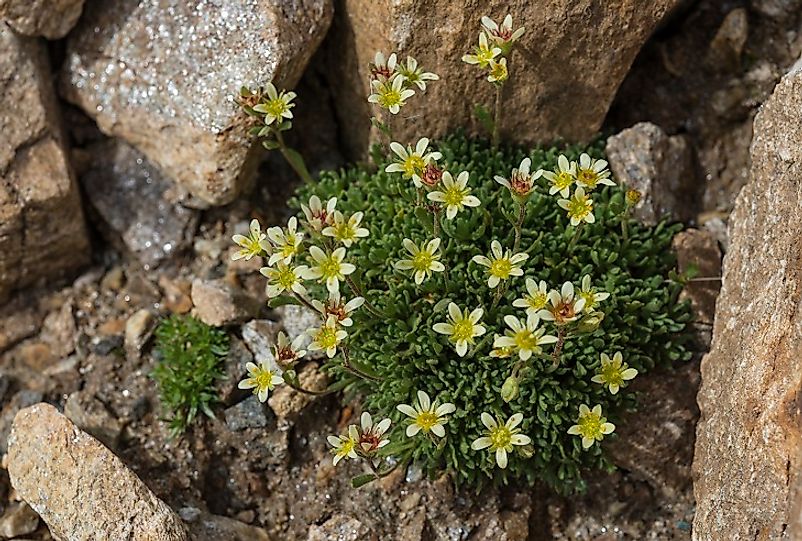Native Plants Of Greenland

A look at the plants that help put the "Green" in the icy nation of Greenland reveals an extraordinary wealth of flora. The flowering plants and ferns, the lush meadows, and other native plants spring up in summer to give Greenland a charming look. Although Greenland id freezing cold, native plants have adapted to the temperatures and blossom to give a beautiful contrast of icebergs and the white expanse in the country. The vast of life when flowers bloom is fascinating in a country where rainfall is minimal, the temperatures are extremely low most of the year, the lower soil layer is frozen permanently, and the pressure is quite high. Herein are discussed some of the native plants of Greenland.
Common Eelgrass (Zostera marina)
Common Eelgrass (Zostera marina) is a seagrass species native to marine environments, especially those along the coastlines of North America and Eurasia. This seagrass is a flowering plant and a rhizomatous herb. The rhizome grows horizontally attaching to substrates. The plant is monoecious and capable of undergoing sexual reproduction or vegetative propagation. Seeds usually have a clear coat and in vegetative reproduction new stems arise from the rhizome and spread into a meadow-like colony. The primary issue facing the population of the common Eelgrass is the increase in turbidity in its natural habitat. The plant needs sunlight but human activities such as trawling and dredging have led to reduced population. Pollution from industries, coastal development, and aquaculture operations destroy colonies and damage the plant's natural habitat. Other invasive species also affect the Eelgrass for instance the green crab which destroys the eelgrass' natural habitat and the slime mold that cause diseases.
Brittle Bladder Fern (Cystopteris fragilis)
Brittle Bladder Fern (Cystopteris fragilis) is a fern species found in moist and shady areas. They also grow on calcareous cliffs, dam rocks and walls, and thin soil covering rocks. The fern usually avoids acidic rocks. The fragile northern fern is distributed from the Arctic in Greenland to the South California, New Mexico, and Illinois. The plant prefers rock as a substrate. The fronds are around 40 centimeters long, and are borne on fleshy petioles. The leaves are divided into leaflets with lobed segments. The underside of each leaf has many sori that contain the sporangia, the reproductive unit of a fern. Each sorus has 4 to 10 sporangia. The spores are brown in color. There is no vegetative reproduction in the fragile fern life cycle. When the spores ripen, they are wind dispersed potentially over long distances.
American Dwarf Birch (Betula glandulosa)
American Dwarf Birch (Betula glandulosa) is a birch species native to North America, especially Greenland. It is also found in other cold temperate areas of the continent, such as Alaska, the higher attitudes of California, and the Black Hills of South Dakota. The shrub birch is multi-stemmed, rising to around 3 meters in height, and forms dense thickets. The trunks are smooth and slender with a dark brown bark. The leaves are circular or oval with toothed margins. The plant flowers in late springs. The flowers are monoecious. Preformed flowers appear at the end of the summer on the aments. When the female catkins get pollinated, they form small nutlets, and each nutlet has one seed. By early August seeds ripen and are ready for dispersal. The shrub also reproduces through vegetative propagation. A paper birch can regenerate from sprouts especially those of young trees cut in the spring. Vegetative reproduction is seldom but precious as a seed replacement during droughts and other difficult times. The altitude range is 1,300 to 11,000 feet, and Betula glandulosa is cold tolerant growing abundantly in permafrost areas.
Long Beechfern (Phegopteris connectilis)
The Long Beechfern (Phegopteris connectilis) is a perennial plant consisting of a loose cluster of compound leaves growing upon slender petioles. The petioles are straw-colored at the base with scales. Similar to most ferns, the leaves divide into leaflets which have sori on the underside. The sporangia reach maturity by mid-summer. The rhizome is long-creeping, branching and has black ovate scales. The fronds are deciduous and monomorphic. The fern grows well in boreal, wet temperate, cold climate and moist calcareous cliff crevices. They are hardy and cold tolerant able to withstand the ice sheets of Greenland. The native Long Beechfern is rare and mostly listed as endangered.
Threats to Greenland's Cold-Hardy Flora
With the freezing temperatures that seldom rise above 5 degree Celsius, Greenland supports only plants adapted to the extreme conditions of the country. From the description of the native plants above, these ferns and Eelgrass are cold tolerant and hardy. The flora of this ecosystem is vulnerable to even the smallest disruptions. As a result, climate changes all over the world are the primary threats facing the "Green" of Greenland.
Native Plants Of Greenland
| Native Plants of Greenland | Scientific Name |
|---|---|
| Common Eelgrass | Zostera marina |
| Brittle Bladder Fern | Cystopteris fragilis |
| American Dwarf Birch | Betula glandulosa |
| Long Beechfern | Phegopteris connectilis |
| Alpine Pussytoe | Antennaria alpina |
| Arctic Mouse-Ear | Cerastium arcticum |
| Alpine Saxifrage | Saxifraga paniculata |
| White Arctic Whitlow Grass | Draba fladnizensis |
| Northern Jacob's Ladder | Polemonium boreale |
| Rosy Pussytoe | Antennaria rosea |











